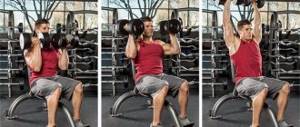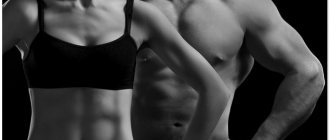Cluster sets for muscle growth - training program. Find out how this training method helps you gain muscle mass and improve endurance.
Cluster sets for muscle growth - training program
Cluster sets are sets of low reps separated by a short rest period during which the muscles relax slightly. The exercises are not performed to failure, but they are a good way to increase the intensity so that you are ready to perform more working sets.
For example, you can perform 10 repetitions of bench press with a certain weight. Try 4 reps first. Now place the barbell back on the racks, rest for 15 seconds and do 4 more. Continue until you have completed 10 of these sets (for a total of 40 reps).
The cluster set can be performed with any given number of repetitions and sets. You can also change the rest time to suit your training specifics.
It is recommended to take a pause of 15–60 seconds between each cluster approach. For the most energy-intensive exercises, such as squats or deadlifts, it may also be necessary to extend the rest time between sets to 120 seconds.
Progression of loads in cluster approaches
To progress, you need to strive to increase working weights when performing cluster sets. The load must constantly be increased. To do this, it is best to complete the planned number of repetitions and sets and increase the working weight in the next workout.
For example, you want to do 8 sets of 4 reps of barbell curls using the cluster principle. You select the appropriate weight and begin the exercise. The total is, say, 4-4-4-4-4-3-3-2 repetitions with a weight of 40 kg. You did 8 sets in total, but couldn't complete 4 reps on each one. In the last three sets, you reached failure by doing fewer reps. Continue using the same weight until you can complete 8 sets of 4 reps. Then increase the weight to 42.5 kg.
This is a simple and effective way to progress loads that will lead to muscle gain.
And you won't have to resort to countless high-intensity training methods.
Complex sets. Exercises
● Briefly about the main thing Two exercises performed one after another in a row for one muscle group with minimal rest or without it are called a complex set. What is it for? The creators classify complex sets as methods of increasing the intensity of training, and by intensity in bodybuilding they usually mean the amount of work done per unit of time. A complex set allows you to complete the planned volume of training in less time, since you will combine some of the exercises for the muscle group being trained, performing them without a pause. Instead of three sets of bench presses and three sets of dumbbell flyes, you can do three complex sets combining these exercises ● Full article Let's consider the pros and cons of the “complex sets” training method, based on the physiology of muscle activity and the theory of muscle tissue growth. 1. The first, most obvious advantage is an increase in the time the muscle is under load. We know that doing an approach for too short a time weakly stimulates protein synthesis, and too long leads to excessive acidification of muscle fibers with hydrogen ions and destruction of protein structures in them, simply - catabolism. Thus, the advantage of a comprehensive set can also be a disadvantage if it ends up being too long. 2. The second advantage is as follows. By wisely selecting pairs of exercises, we can combine the advantages of basic and isolation exercises in one approach. The good thing about a basic exercise is that it allows you to engage several muscle groups at once, which means using the maximum possible weight, which in turn causes the most significant hormonal changes in the body, in particular, an increase in the secretion of anabolic hormones. Any basic exercise in bodybuilding, although it involves more than several muscle groups, is aimed primarily at the development of one of them. For example, the bench press is an exercise that is used to develop the pectoral muscles, but in addition to the pectoral muscles, it also involves the deltoids and triceps. The vertical pulldown is designed for the latissimus muscles, but the forearm flexors also play a significant role in the movement. That is, there are muscles that are main in the exercise, and there are auxiliary ones. Sometimes it happens that for some athletes, due to the characteristics of the technique they use or the structure of the skeleton, the auxiliary muscles participate on an equal basis with the main ones or even dominate. In this case, the exercise does not bring the desired result in the development of the target muscle group, since the load it receives when reaching failure does not cause the necessary changes in the muscle fibers. That is, growth factors do not yet have time to accumulate in optimal quantities by the time the approach is stopped due to local fatigue. And this is where an isolation exercise can help. An integrated approach, consisting of a basic and isolating exercise, will extend the load time in the muscle group that we are training, which means that growth factors will continue to accumulate in it in greater quantities. The bench press and the bent over dumbbell fly that follows it without a break allow you to develop your chest more specifically and effectively. And here we again return to the disadvantage of using complex sets - too long a load. How to avoid this? We have already written about such a method as “rest-pause,” which also saw a similar problem, and the solution to it was to perform the first, main approach in a small number of repetitions with a large weight. Heavy weight allows you to recruit more muscle fibers into work, while limiting the ability to do many repetitions, which in turn does not lead to severe acidification. And subsequent approaches with short rest intervals (20 seconds) prolong the time that growth factors are present in the working muscle fibers. You can extend the analogy to complex sets. The first exercise, basic, must be performed with heavy weight in the range of no more than 5–8 repetitions until failure; do the second exercise, isolation, with an average weight in the range of 10–12 repetitions. This adds up to 15 to 20 reps, which is certainly a better growth stimulant than just 5 to 8 without being overly acidifying. These numbers can be applied to all muscles of the upper body. And for training the quadriceps, it is better to make the numbers larger, given that it has a different muscle composition. For example, 8-10 in the first set and 12-15 in the second, for a total of 20 to 25 repetitions. Examples of combinations • Chest Horizontal barbell press + dumbbell fly; Bent-over dumbbell press + abbreviation in the machine (“butterfly”); Bench press in the Hammer simulator + pruning in the Crossover. • Back Wide-grip vertical block row + pullover in the machine; Bent-over barbell row + pullover in the simulator. • Shoulders Seated overhead press in the “Smith machine” + dumbbell swings to the sides. • Quadriceps Squat with a barbell + extension of the lower leg in the simulator; Leg press + calf extension in the machine. In general, with regard to leg training, complex sets can be built based on the fact that in movements such as squats with a barbell, squats in the “Hack-trainer”, leg press, not only the quadriceps, but also the hamstrings and gluteal muscle. Therefore, pairs can be selected so that the second exercise for the listed basic movements can be those that isolate the hamstrings and gluteus. This is only if there is a need for it. • Biceps femoris Squats with a barbell + flexion of the lower leg in the simulator; “Hack” squats in full amplitude + hyperextension. • Gluteal squat with a barbell + hip abduction in a special machine. Rest between approaches and number of approaches When using complex sets in a training program, the rest between them should be quite long and reach 8–10 minutes. In between, you can do other exercises for other muscle groups included in your split. The total number of complex sets per muscle group per workout can be limited to three to four, provided that this will be the only type of load on the muscle.
Variations of cluster sets
Don't make things more difficult for yourself by using cluster approaches. First, determine how your body reacts to such a load, and only then think about training all muscle groups according to this principle. Avoid overtraining and don't let your muscles ache for too long after exercise.
10 cluster sets of 4 reps
Rest between sets for 15–60 seconds. There is no need to reach failure. Once you can complete 10 sets of 4 reps, increase the weight.
10 x 4 is a good option for training priority muscle groups, such as the chest, back and shoulders. If you do not have time to properly feel the work of your back during this time, increase the number of repetitions to 5–6.
8 cluster sets of 3 reps
The 8 x 3 pattern is suitable for heavy, energy-intensive exercises like squats or deadlifts. It is recommended to rest for 30–120 seconds between such approaches.
Performing squats or deadlifts using the cluster set principle overloads the lower back, especially in the last sets. If you feel that the load on the spinal extensors is too much, switch to an 8 x 2 or 10 x 2 pattern.
6 cluster sets of 6 reps
For smaller muscle groups (biceps, triceps, trapezius, hamstrings), it is recommended to perform fewer sets and more repetitions. You can also use the 6 x 6 technique for isolated movements such as machine leg extensions, dumbbell flyes, or dumbbell lateral swings.
The 6 x 6 scheme is suitable for those who like to perform many exercises in one workout. If desired, you can modify it and make, for example, 5 x 6 or 5 x 5.
Useful article: “15 techniques for effective training to gain muscle mass”
COMBI-SETS (forearms/abs/calves)[edit | edit code]
In a strict sense, combined sets are performing one after another (without rest!) two different exercises for one muscle. For example, lifting up on a Scott bench after the classic standing up with a barbell. The biceps is subjected to a massive attack from several directions at once and usually gives up: it begins to grow. In our case, we will talk about a combination of exercises for three muscles at once that give amateurs the most trouble - forearms, calves and abs. There is no need for rest between exercises. Well, rest 1-2 minutes between combi-sets. Combo sets turn work on small muscles, usually boring and monotonous, into an interesting competition with yourself. Alternating different types of exercises does not tire the psyche at all. On the contrary, it’s tempting to set a record in every movement.
Combo sets for forearms, calves and abs should be separated into a separate workout. Since you will do all the exercises with utmost dedication, its energy consumption will become extreme and will leave no strength for other muscle groups.
Combi set
Forearms Wrist curls 3/15 Abs Hanging leg raises 3/15-20 Calves Standing calf raises 3/20 rest 1-2 min.
Combi set
Forearms Wrist extensions 3/15 Press Crunches 3/25-35 Calves Seated calf raises 3/20 rest 1-2 min.
Training program with cluster sets
When using cluster approaches, a 4-day split of the following type is suitable:
- chest and triceps,
- back and biceps,
- rest,
- rest,
- shoulders and trapezius,
- legs,
- rest.
Day #1: Chest and Triceps
- Bench press - 10 x 4
- Barbell or dumbbell bench press on an incline bench - 6 x 6
- Butterfly raises or dumbbell flyes - 6 x 6
- French bench press with barbell - 6 x 6
- Arm extensions with a dumbbell from behind the head while sitting - 6 x 6
Day #2: Back and Biceps
- Deadlift - 8 x 3
- Bent-over barbell row - 8 x 5
- Pull-ups or lat pull-downs - 6 x 6
- Arm curls with a barbell or dumbbells - 8 x 5
- Hammers with dumbbells - 5 x 6
Day #5: Shoulders and Traps
- Seated barbell or dumbbell press - 10 x 4
- Arnold press or dumbbell swings in front of you - 6 x 6
- Barbell row to the chin or dumbbell swings to the sides - 6 x 6
- Shrugs with dumbbells or barbell - 10 x 6
Day #6: Legs
- Barbell squats - 8 x 4
- Front squats or leg extensions in the machine - 6 x 6
- Lying leg curls or Romanian deadlifts - 8 x 6
- Calf raises standing or sitting - 8 x 10
IN BETWEEN[edit | edit code]
Few people liked to pump calves even at the dawn of bodybuilding. However, skinny calves were considered a disgrace. The solution was found in the form of intermediate sets. This tricky technique, which has been around for decades, is similar to supersets, only you have to combine not antagonist muscles, but a large muscle group and those small muscles that need to be tightened. Simply put, you should sandwich calf exercises between chest exercises. Why not backs? Yes, because many exercises for the back have to be done in a standing position, and weakened, exhausted calves can do a disservice here.
Rest between intermediate sets is minimal and amounts to 30 seconds at most. We are talking about different muscles after all. While you pump your chest, your calves rest, and vice versa. As a result, the workout is greatly shortened. If you were to steadily do set after set as usual, you would spend 15 minutes longer in the gym.
However, the most important thing lies in this. that the technique allows you to do at least 4 different exercises for the calves without even noticing it, and even 3 sets in each. Admit it honestly, this is hardly possible with a different set of exercises. Imagine, you can barely stand on your feet after doing heavy bench presses, and you have a long and tedious calf workout ahead of you! Here's another advantage of intermediate sets. Science has found that focusing on your calves erases the short-term memory of a recent chest exercise. So, you greet a new exercise for the chest with an unusually “fresh” psyche, which simply does not remember the severity of the presses done. As a result, mental concentration on the pecs remains phenomenally high until the very end of the workout, and therefore the impact of the training becomes downright brutal!
Chest Incline Bench Press 3/8 rest 30 sec. Calves Standing calf raise 3/12 rest 30 sec. Chest Dumbbell bench press rest 3/10 rest 30 sec. Calves Seated calf raise 3/20 rest 30 sec. Chest Oblique flyes 3/12 rest 30 sec. Calves Toe press 3/15 rest 30 sec. Chest Crossovers on blocks 3/15 rest 30 sec. Calves Standing calf raise 2/25 rest 30 sec. Only perform standing calf raises between the first set of crossovers. After the final set of crossovers, do calf raises as desired.











